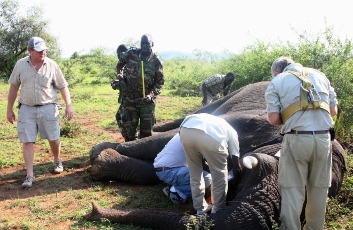South Sudan collars wild animal to develop eco-tourism
August 22, 2009 (JUBA) — South Sudan authorities and a US nongovernmental organization for the first time finalized an operation to track the migration of wild animals in order to develop protected areas and eco-tourism.

The USAID funded operation covered Jonglei, Eastern Equatoria, and Central Equatoria States including Badingilo National Park, Boma National Park, Nimule National Park, Jonglei plains, and the Sudd wetlands.
“This is another key step for us in building our understanding of the wildlife migrations in the region which will help my Ministry and its partners in planning management and tourism development strategies in order to contribute to the development of Southern Sudan” said Mrs. Agnes Lukudu, GOSS Minister for Wildlife Conservation and Tourism.
“The tracking devices are already generating useful information,” said a statement issued by the southern Sudan ministry and the WCS. They added the collected data would be integrated into management strategies and promotion of tourism in the region.
During this first phase of the collaring operation, 9 Elephant, 12 Tiang, and 12 White-eared kob were successfully collared. Further collaring of animals will be undertaken in the dry season to expand data and information collection.
The GPS/Satellite tracking will provide concerned authorities with accurate information on the migratory patterns of these species, help identify corridors necessary for sustaining the migrations in the long run, inform land-use planning and protected area management, and reveal areas which can be prioritized for eco-friendly tourism development.
“By knowing where the animals are moving we can better orient our anti-poaching efforts to protect them and also identify key habitat areas requiring conservation management,” said Mr. Frazer Tong, Undersecretary of wildlife ministry.
(ST)

Maruon Ayiei
South Sudan collars wild animal to develop eco-tourism
This is what we want to see in the south. Get to work.
Kur
South Sudan collars wild animal to develop eco-tourism
Perhaps there is a need to collar the criminals who are wanted by the International Criminal Court so that they have nowhere to hide in the desert. Noble men and women never run away from justice because they have nothing to fear. Salva and Pangan along with other noble leaders of the SPLM are heros, who have made their way to public arena with clean record. So they will be remembered as such.
Kur
[email protected]
South Sudan collars wild animal to develop eco-tourism
??? ?????????
?????? ??????? ???????
????? ?????
???? ?????
???? ?????
????? ??????
????? ? ?????? ???????
????? ?????
????? ????????
?????? ?????????
?????? ????? ?????
????? ??????
???????? ?????
?????? ?? ?????? ??????
??? ???????
??? ??????? ?????????
???? ?????? ??????
??? ????? ?????
???? ????
???????? ??????
????? ????????
????? ?????
??? ??? ?????
???? ???????
????? ?????? ????? ???????
???? ??????? ????????
?????? ???????
???? ???????? ?????? ????
?????? ?????? ????
?????? ????? ?????????
???? ?????? ?????
????? ???????? ??????????
??? ??? ?????